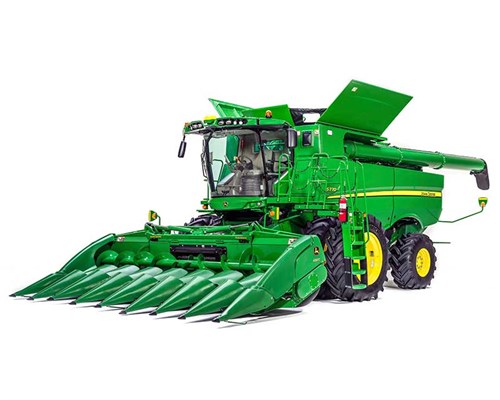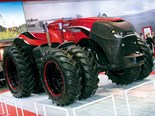Profile: S700 series John Deere combine harvester
 The S700 John Deere harvester is due to arrive in New Zealand in 2018
The S700 John Deere harvester is due to arrive in New Zealand in 2018

 A computer model of the rotary combine
A computer model of the rotary combine

 Maintenance is easy on the folding corn head, as the tips fold up for great access to the inner workings
Maintenance is easy on the folding corn head, as the tips fold up for great access to the inner workings

 Front view of the 608C corn head
Front view of the 608C corn head

 As seen here and above, the panels open easily for great access around the machine
As seen here and above, the panels open easily for great access around the machine

 The S670 specially fitted with tracks to aid traction and reduce compaction
The S670 specially fitted with tracks to aid traction and reduce compaction

 John Deere 608C folding 8 row corn head with stalk chopper
John Deere 608C folding 8 row corn head with stalk chopper


|
|
The S700 John Deere harvester is due to arrive in New Zealand in 2018
|

|
|
A computer model of the rotary combine
|

|
|
Maintenance is easy on the folding corn head, as the tips fold up for great access to the inner workings
|

|
|
Front view of the 608C corn head
|

|
|
As seen here and above, the panels open easily for great access around the machine
|

|
|
The S670 specially fitted with tracks to aid traction and reduce compaction
|

|
|
John Deere 608C folding 8 row corn head with stalk chopper
|
Farm Trader calls in on the Cervus Equipment training day, checking out the future of farming and discussing the new 2018 S700 series John Deere combine harvester
The release of the new John Deere Starfire 6000 is hugely exciting, with repeatability guaranteed for nine months from the previous job. John Deere professionals say it will last the season (12 months) but will guarantee nine months of repeatability.
This means cultivation, planting, spraying, fertilising, harvesting, and re-cultivation can all be accessed from the receiver and go on any AutoTrak ready machine in the fleet.
If that isn’t exciting enough, accuracy of +/- 3cm is probably the best feature. Three centimetre is almost as good as RTK at 2.5cm without the need for a $25,000 base station (although the RTK will gain coverage quicker in challenging conditions).
Gen 4 Command Centre
The next exciting rollout is the Gen 4 Command Centre. The 4100 monitor is optional on CommandArm machines and is the intuitive 10-inch touchscreen controller for the tractor.
You can either upgrade to the 4600 monitor as the main screen off the CommandArm or run a 4600 or the lower spec 4640 screen for additional implement functionality.
Both the 4600 and 4640 are touchscreen with ISOBUS and split screen capability. The 4640 for around $2500 makes good sense for an additional screen in the cab to run ISOBUS implements or GPS, while still having the main tractor functions on the tractor monitor.
JDLink
JDLink is another option that has been around for a while and is available as a phone app. It’s becoming more commonly used due to the useful information, which can be gathered.
With some tractors having up to 50% idle time, combine information can be broken down to idle, idle with full tank, transport, etc. Users can also export yield and coverage maps as well as guidance line sharing via JDLink.
This is a great function for contractors and farmers to be able to track productivity as well as remote diagnostic reports for the service centre. It also allows some fixes to be sent from the diagnostic team directly to the tractor to resolve issues in the field without a mechanic needed.
Expert Alert
Another exciting feature John Deere is working on is called Expert Alerts. This is where the reporting of diagnostic alerts and temperatures is monitored by John Deere and this is currently on some machines with JDLink, which allows them to have a large database.
In the future, information will be sent directly from the factory to the local service manager, predicting the fault that will occur on the machine before it has even occurred. This information will also include the parts required to fix that problem.
This saves both the dealer and customer from sending technicians out to a job, diagnosing the problem, going back to the workshop, ordering parts, waiting for parts to arrive, going back out to the machine all the while losing several days in the meantime, essentially reducing admin and downtime – I’m not a fan of admin.
S700 Series Combine Harvesters

Ian Henderson, the manager in charge of training and a shareholder at Cervus Equipment Canada is passionate about combine harvesters, delivering an insightful and animated presentation at the Cervus Equipment training day in Hawke’s Bay.
In New Zealand, the market for combine harvesters is extremely small, particularly when compared to that of his hometown in Canada, where the combine market represents 45% of the total sales, so they are justifiably excited about the S700 series arriving.

The newest John Deere S700 series rotary combine is expected to arrive in New Zealand in 2018. The four-model line-up is the S760, S770, S780 and S790. These are all equipped with the same engine power and capacity as the S600 series.
The upgrades are what John Deere calls ‘creature comforts’ and technology upgrades, with only minor tweaks to the design and components of the machine itself.
ICA2
Once the smart combine has been initially set up, the Interactive Combine Adjustment system (or ICA2) constantly monitors through cameras and sensors. It adjusts the machine’s settings to maximise quality while minimising losses through varying crop conditions, dry matter, and weather conditions, which are all part of harvesting.
ICA2 can take pictures, which allows things such as half broken kernels to be identified and colour-coded.
For example, you might colour code a broken kernel as pink and chaff as yellow. The ICA2 will pick them up as they are going through the elevators, clean grain and the tailings. As it takes the samples and snapshots, it then auto adjusts to the preset sensitivity and maintains it to maximise productivity.
OTher technological features
Other features include camera ready, where pre-wiring in the machine allows camera feeds in the tank, on the spout, and to the rear. This is then linked to the standard 4600 display, along with the new Gen 4 CommandArm with the CommandPro joystick, which has five individually programmable buttons.
This is a big step up from the three currently available in the S600 series. The CommandPro Gen4 armrest is the same as the new 6230 and 6250R tractors. Like many leading manufacturers, attention is being given to trying to create a consistent operating environment throughout the range of both tractors and harvesters. This allows significant ease of use for operators when it comes to fleet machines.
The machines have been extensively tested throughout Northern America and Canada. With 51 units working around the world as we go to print, the 2018 model will hit the ground running. And even better is that New Zealand will be able to get the nine- or 13.5-litre engines in Tier 2 spec, which is a huge bonus.
Keep up to date in the industry by signing up to Farm Trader's free newsletter or liking us on Facebook



.jpg)









